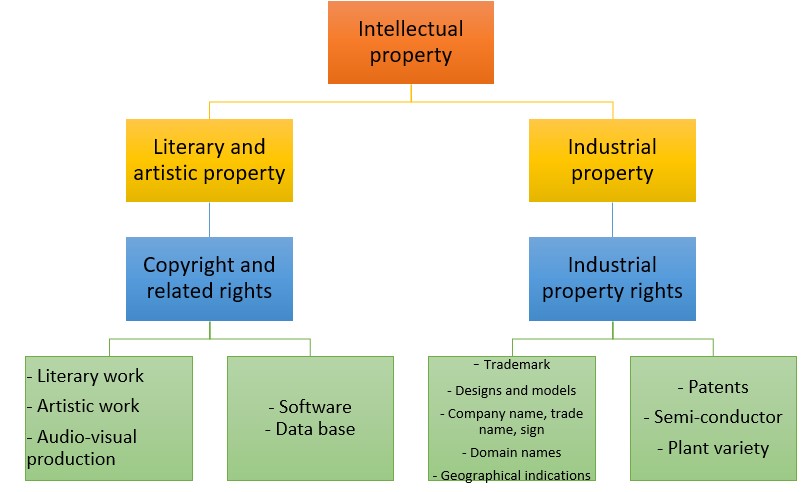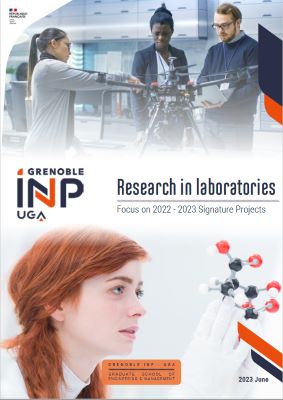article written by Isabelle Chéry and Jana Darwiche
Intellectual property (IP) is a crucial factor in innovation and economic competitiveness. It is a fundamental concept, as it confers on its owner strong prerogatives, in particular the right to exploit his intellectual creations in the socio-economic world and to prohibit others from exploiting them without his authorisation. Intellectual property rights therefore provide a competitive advantage to the one who has the authorisation to exploit it. IP rights influence most of our personal (consumer habits, leisure activities, etc.) and professional (e.g.,, industrial production) daily lives.
I- What is intellectual property?
Inventions or intellectual creations can lead to the generation of various exclusive intellectual property rights. Intellectual property rights are organised into two main groups: industrial property and literary and artistic property.I- 1 Industrial property
The purpose of industrial property is to protect technical or aesthetic creations or distinctive signs. Industrial property plays a key role in economic issues, particularly in the production and distribution process. Industrial property is an instrument for restricting or stimulating competition, encouraging innovation and enabling companies to distinguish their products and services from those of competitors. It is linked to several important issues for companies: making creativity and innovation efforts profitable, developing the company’s value and taking possession of the knowledge it creates through its protection.
Industrial Property rights include:
- technical creations:
o The patent (P for Patent),
o The supplementary protection certificate is an extension of the patent in the fields of plant health and medicines, i.e., for products that must be authorised for marketing.
o The utility certificate is a mini-patent. It is subject to the same protection conditions as a patent. The differences with the patent concern the duration, which is 6 years whereas it is 20 years for a patent, and the legal security, which is less insofar as there is no prior art search by the national patent offices.
o The plant variety certificate to protect the activity of breeding any plant material (horticultural cultivar or agricultural seed), i.e., the process by which man modifies a plant species.
o Semiconductor topography, i.e., the protection of the three-dimensional pattern obtained by superimposing the different layers constituting the semiconductor (conducting, insulating or semiconducting layer).
o The supplementary protection certificate is an extension of the patent in the fields of plant health and medicines, i.e., for products that must be authorised for marketing.
o The utility certificate is a mini-patent. It is subject to the same protection conditions as a patent. The differences with the patent concern the duration, which is 6 years whereas it is 20 years for a patent, and the legal security, which is less insofar as there is no prior art search by the national patent offices.
o The plant variety certificate to protect the activity of breeding any plant material (horticultural cultivar or agricultural seed), i.e., the process by which man modifies a plant species.
o Semiconductor topography, i.e., the protection of the three-dimensional pattern obtained by superimposing the different layers constituting the semiconductor (conducting, insulating or semiconducting layer).
- aesthetic creations: the design which is defined by the appearance of the product or part of the product:
o Appearance is defined as the shape, contours, texture, materials, colour of the product, and/or its ornament.
o Designs apply to industrial and craft products.
o Designs apply to industrial and craft products.
- Distinctive signs:
o Trademark (trademark, service mark, or commercial mark) is a sign capable of being represented graphically to distinguish natural or legal person's services or products.
o The company name is the legal name of a commercial company as set out in the articles of association of the commercial company concerned. It is the name under which the company is registered in the Trade and Companies Register and under which it carries out its activities
o The trade name is one of the intangible elements of the business. It is the name under which the company’s activity is known to the public (materialized by its sign), and may be different from its corporate name
o The sign is the name under which the business is carried on and known to the public, which the trader affixes to his shop window, his delivery vehicles, etc. It is the extension of the business name. It is an extension of the business name.
o The domain name is an Internet address: it is the equivalent of a postal address but on the Internet.
o Geographical indication is a sign used on products that have a specific geographical origin and possess qualities or a reputation due to that place of origin. In most cases, a geographical indication consists of the name of the goods' place of origin.
o The company name is the legal name of a commercial company as set out in the articles of association of the commercial company concerned. It is the name under which the company is registered in the Trade and Companies Register and under which it carries out its activities
o The trade name is one of the intangible elements of the business. It is the name under which the company’s activity is known to the public (materialized by its sign), and may be different from its corporate name
o The sign is the name under which the business is carried on and known to the public, which the trader affixes to his shop window, his delivery vehicles, etc. It is the extension of the business name. It is an extension of the business name.
o The domain name is an Internet address: it is the equivalent of a postal address but on the Internet.
o Geographical indication is a sign used on products that have a specific geographical origin and possess qualities or a reputation due to that place of origin. In most cases, a geographical indication consists of the name of the goods' place of origin.
I.2 Literary and artistic property
Literary and artistic property is subdivided into copyright, neighbouring rights (rights of producers of videograms, performers' rights, etc.), software and databases. Artistic and literary property aims to protect all works of the mind, e.g., musical compositions, sculpture, novels, short stories, poems, etc. Creators of copyrighted works enjoy some basic rights under copyright law. They have the exclusive right to use the work and may prohibit or authorise its reproduction, performance, communication to the public and translation into other languages.

II- What are the rights relating to the main intellectual property rights?
Intellectual property rights generally arise from a declaratory act formalised by a deposit. This registration is managed on a territorial basis: each country has dedicated bodies. In France, it is the National Institute of Industrial Property (Institut National de la Propriété Industrielle, INPI). The registration specifies the characteristics to be protected: distinctive signs that can be appropriated by the trademark, functional creations that can be appropriated by the patent, the design for drawings and models, etc. Only copyright is exempt from this registration principle.
- Copyright
- Software
- The law on databases
- Patent law (P for Patent)
- Trademark law
- Descriptive (e.g., sifted, for flour)
- Usual (e.g., the name of the molecule for a medicine)
- Necessary (e.g., entrecote for a meat restaurant or a drawing of a cow silhouette for a dairy product).
This right does not allow the owner to be rewarded for a creative contribution that enriches society. The protection conferred on the trademark owner consists in obtaining an exclusive right to use the trademark to designate goods or services.
- Design and model law
III- What if a creation is not protectable by industrial property rights?
Depending on the invention characteristics, it may be decided to prefer (secret) know-how to patenting either for strategic secrecy reasons (the patent being published within 18 months of filing), or because patenting is not feasible if the invention does not meet all the patentability criteria. Know-how is a term used to designate a body of technical knowledge, business or organisational practices that are secret and not patented. It must be secret, substantial, i.e., it must have an economic utility (not necessarily a technical utility), it must be identified, i.e., it must be sufficiently described for someone else to be able to implement it and finally it must be transferable, i.e., it must be reproducible. Know-how is often made up of product manufacturing secrets, specific processes, etc.
The only way to protect it is to keep it secret by taking measures such as: the development of secure areas within research and manufacturing sites where information is compartmentalised or the signing of confidentiality agreements for people accessing secret knowledge to prevent unauthorised people from gaining access to it.
Do you have questions? Do you think that the results of your research may lead to intellectual property rights or know-how?
Please feel free to contact us: drive.pi@grenoble-inp.fr or Yoann Miccoli, in charge of Intellectual Property at 04 76 57 43 09.




